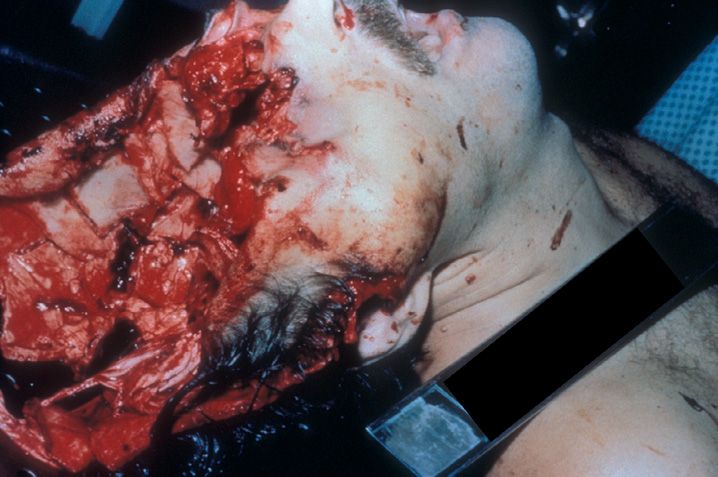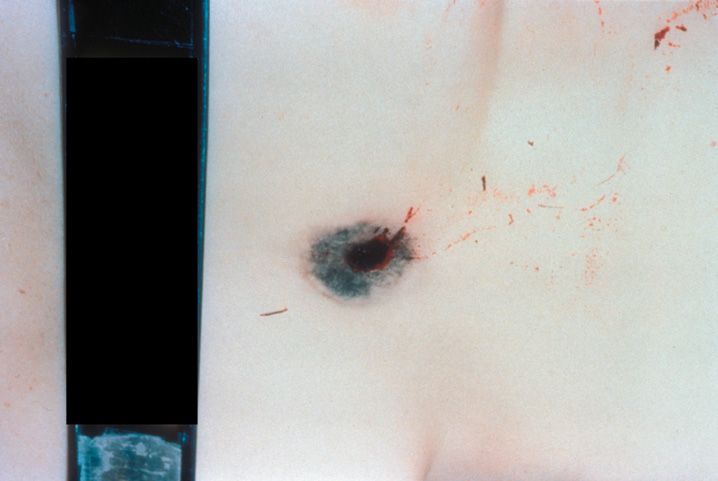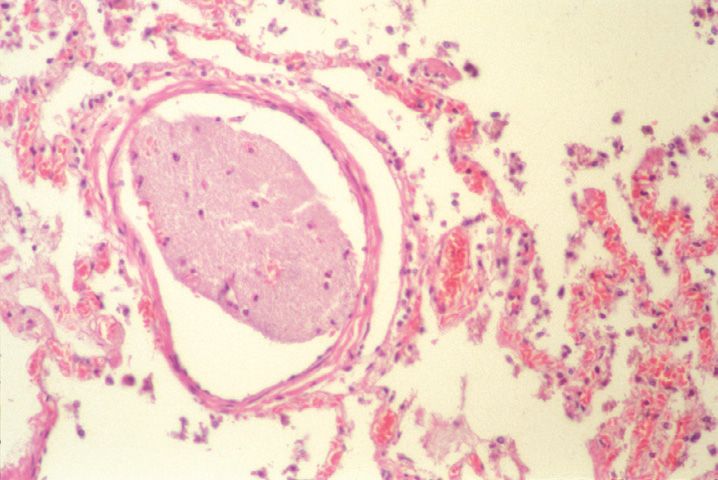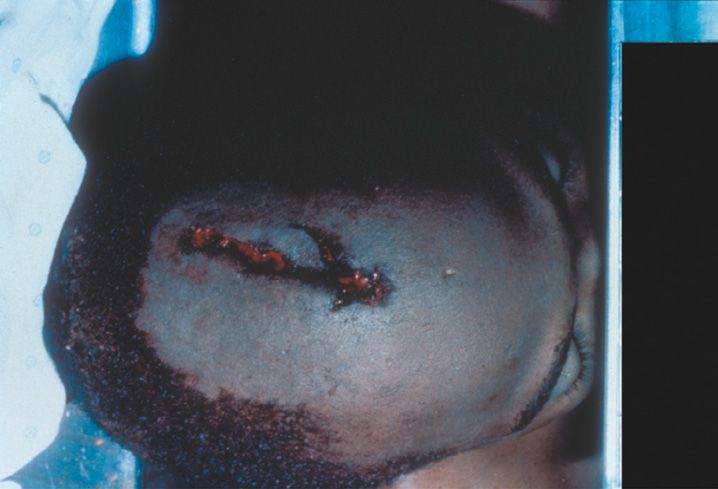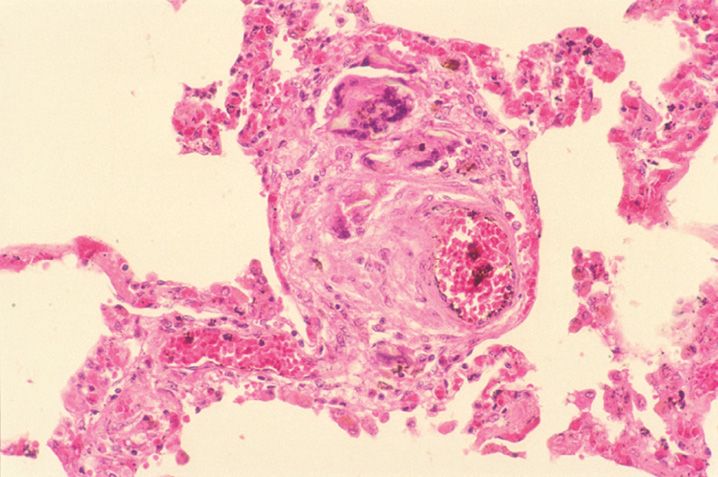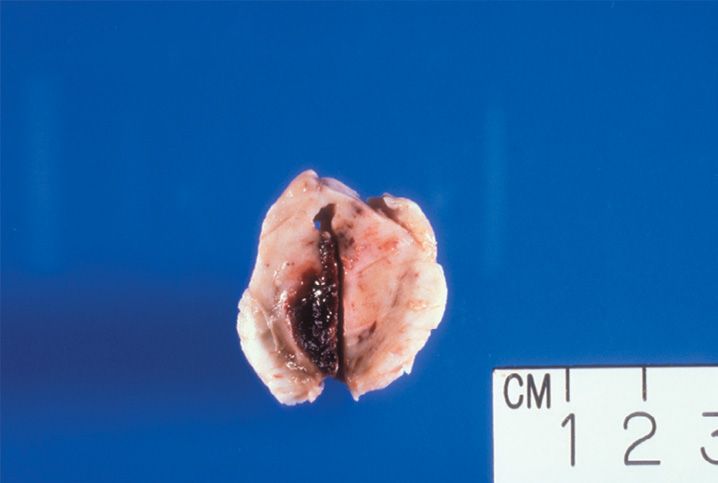FIGURE 12-1
(A) Allergic reaction to algae
(B) Cannot tell from this figure
(C) Fungal infection
(D) Parasitic infection
(E) Portuguese man-of-war sting
82. The most likely manner of death in this 39-year-old man is (Figure 12-2)
(A) Accidental
(B) Homicide
(C) Natural
(D) Suicide
(E) None of the above
83. The injury shown in Figure 12-3 in this 52-year-old woman represents which of the following?
(A) Electrical burn
(B) Gunshot entrance wound
(C) Gunshot exit wound
(D) Knife wound
(E) Result of blunt trauma
84. On examination of the lung in a 28-year-old man, this finding was observed. The most likely cause of this finding is (Figure 12-4)
(A) Aspiration
(B) Fall from a high-level bridge
(C) Gunshot wound to the head
(D) Multiple bone fractures
(E) Strangulation
85. The most likely underlying pathophysiologic factor for the pathology shown in Figure 12-5 is which of the following?
(A) Metastatic spread of a pulmonary carcinoma
(B) Neoplastic transformation of meningothelial (arachnoidal cap) cells
(C) Penetrating wound (gunshot)
(D) Rotational movement of the brain in the skull
(E) Sudden acceleration or deceleration of the skull relative to the brain
86. A 36-year-old man died of a gunshot wound to the chest. No other objects are found at the scene. At autopsy, you notice this injury on the scalp. The most likely etiology would be which of the following? (Figure 12-6)
(A) Blunt trauma wound
(B) Defense wound
(C) Knife wound
(D) Laceration due to fall
(E) Superficial gunshot wound
87. A 34-year-old anesthesiologist was found dead in his car in a parking lot. His pants were down at his ankles and his head was leaning back on the top of the seat. At autopsy, needle puncture marks were found in his genital and inguinal region. A syringe was found on the floor of the car. Figure 12-7 shows a section taken from the lung and supports which of the following?
(A) Amphetamine overdose
(B) Aspiration
(C) Autoerotic asphyxia
(D) Blunt trauma to the chest
(E) Ventricular arrhythmia
88. The finding illustrated (in Figure 12-8) in this 56-year-old man is most likely associated with which of these findings?
(A) Bifrontal contusion
(B) Diffuse axonal injury
(C) Infarct in the posterior cerebral artery distribution
(D) Right occipital lobe metastatic melanoma
(E) Vertebral artery aneurysm
ANSWERS
1. (B) Due to hypoxia causing confusion terminally.
The most likely cause of contusions and abrasions in this woman was hypoxia causing confusion terminally. The presence of abrasions and contusions raises a suspicion for foul play. Those dying from natural causes may become hypoxic and confused in the endstages of life. They frequently fall and items are knocked over. In the process of falling, they may sustain contusions and abrasions.
2. (D) Ovarian carcinoma.
The presence of blood at the scene of death does not always indicate trauma. There are a variety of natural diseases that may account for bleeding including esophageal varices, pulmonary tuberculosis, and pulmonary carcinomas with hematemesis or hemoptysis. Large tumors under the skin may erode and cause hemorrhage externally. Patients on hemodialysis may have vascular shunts that can erode through the skin and bleed. An ovarian carcinoma may cause hemorrhage internally, but the likelihood of finding hemorrhage externally at the scene of death is less likely than the other options listed.
3. (B) Deliberate.
Forensic autopsies are performed with the goal of determining the cause and manner of death in people. The manner of death is defined as the circumstance under which the person died. The designations that are commonly used to describe the manner of death include natural, accidental, suicidal, homicidal, or undetermined. Deliberate does not indicate a manner of death; the term may imply either a suicidal or homicidal manner.
4. (D) Positional asphyxia.
In some forensic autopsy cases, investigation of the scene of injury or death is important in arriving at the correct cause of death. Positional asphyxia is an example where the position of the body in relationship to its surroundings is critical for making the correct diagnosis.
5. (D) Liver.
For certain cases, it may be important to be able to extract DNA for purposes of identification. Certain tissue types are better utilized to this end. Available blood adequately serves this purpose. The blood standard can be obtained by placing several drops of an individual’s blood on a prepackaged filter paper and then allowing it to dry. The blood in this form does not need to be refrigerated. Skeletal muscle also can provide a good source of DNA. Liver and spleen generally are less desirable organs because they have high levels of autolytic enzymes. In bodies that have undergone more advanced decomposition, teeth, ribs, and femurs are good specimens for DNA. If hair is utilized, it should be pulled and not cut, because much of the valuable DNA is located in the roots of the hair.
6. (E) To prevent possible volatiles (accelerants) from evaporating.
In cases of suspected arson, it is important to store clothing in sealed metal containers. If the clothing is allowed to air-dry before an analysis is preformed, important volatiles that may have served as accelerants might evaporate and will not be detectable. Likewise, bloody clothing from cases of injury should be allowed to dry in a secure place and then packaged in a breathable paper bag before delivery to the crime laboratory.
7. (D) Marfan syndrome.
In younger patients with a history of aortic dissection, Marfan syndrome should be considered in the differential diagnosis. Marfan syndrome is inherited as an autosomal-dominant condition in many cases, and there is a potential genetic implication for surviving family members. This particular patient has many of the typical features of a Marfan patient including tall stature and long arm span, arachnosyndactyly, pectus excavatum, and a high arched palate.
8. (A) Coxsackie A.
In an individual who has prodromal systems of fever and flu-like illness followed by sudden death, a diagnosis of myocarditis should be entertained. In North America and Western Europe, most cases of myocarditis are caused by viral organisms, with Coxsackie A and Coxsackie B viruses being the most commonly encountered viral culprits.
9. (D) Livor mortis.
Livor mortis involves the settling of blood in dependent portions of the vascular system and not the surrounding tissues. Incised areas of livor mortis will not appear hemorrhagic. Livor mortis needs to be distinguished from a contusion or bruise, which usually results from blunt trauma due to the tearing of capillaries and larger blood vessels and an extravasation of blood into extravascular spaces.
10. (A) Blunt trauma.
The scenario represents an example of blunt trauma injury. In external examination, there is very little evidence of trauma. One needs to remember that the appearance of contusion may not be in line with the degree of force used to cause the injury. Individuals on systemic steroids or blood thinning medications may often have prominent numbers of ecchymoses related to bleeding secondary to trauma of relatively little force or in some cases spontaneous hemorrhage. In this child, the internal injuries are severe and are suggestive of trauma, possibly related to abuse.
11. (B) Basilar skull fracture.
Basilar skull fractures are characteristically associated with leakage of cerebrospinal fluid from the nasal cavity and periorbital or postauricular ecchy-moses or bruises.
12. (B) Avulsion.
An avulsion represents a tearing away of tissues from their attachments. In this particular case, a large area of soft tissue is torn from her right leg and buttock region.
13. (E) Unburned skin at the outer edges of the eye.
Injury related to explosions often consists of blunt force injury, often caused by physical objects, and concussive pressure wave or shock wave injuries. In cases of explosion-related injury, the body may be burned in part in the process. If one sees linear streaks of unburned skin at the outer edges of the eyes, similar to crow’s feet, and unburned horizontal creases in the forehead, these findings suggest that the individual was squinting and hence was alive at the time of the explosion.
14. (D) Infection.
Infection is the most common complication of traumatic injuries leading to morbidity and mortality.
15. (D) A 14-year-old pedestrian found by the side of the road.
In cases of a pedestrian found in or around a road, it is appropriate to consider making incisions in the legs in order to identify deep leg bruises that may have been the result of impact of the vehicle on a pedestrian.
16. (D) Metal composition of the blade.
The size and shape of a knife stab wound is dependent on a variety of factors including the type of blade used, the body region stabbed, the depth of insertion of the knife blade, and the angle of withdrawal of the knife. Composition of the metal making up the knife blade does not significantly impact on the size and shape of the stab wound.
17. (A) Abrasion around the stab wound.
The crossguard of a knife is the flared area of protection between the handle and the blade. When the knife is inserted up to the crossguard, there is often evidence of abrasion around the stab wound that is the result of the crossguard making contact with the skin.
18. (A) It cannot be determined be examination of the wound alone.
The handedness of an assailant in a knife stab wound cannot be determined by examination of the wounds alone. If the relative positions of the assailant and the victim are known at the time of the stabbing, an opinion can potentially be generated that suggests that the wound is more consistent with right or left handed assailant.
19. (A) Back.
Defense injuries or wounds are the result of the victim trying to protect himself or herself from an assailant. The labeling of a wound as a defense injury is generally circumstance dependent. Classically, defense injuries involve the hands, arms, and upper arms. The feet may be a site of a defense injury if a victim is on the ground and kicking in an attempt to protect himself or herself from an assailant. Back injury is generally not considered a common defense injury site.
20. (C) Gunshot wounds.
The most common cause of death in homicides in an urban setting in the United States is gunshot wounds.
21. (E) Stretch lacerations along the bullet path.
Findings that are suggestive of an entrance contact range gunshot wound include a muzzle imprint, gunpowder residue staining the wound edges dark gray or black, or evidence of soot in the wound. Hard contact gunshot wounds, where the muzzle is pressed firmly against the skin, can result in a stellate-shaped wound (tear). Stretch lacerations along the bullet path are less specific and are not necessarily seen exclusively with contact range gunshot wounds.
22. (B) Homicide.
This case raises the issue of delayed gunshot would death. The gunshot wound in this case started a series of events that ultimately culminated in the patient’s death. The death can be attributed to the gunshot wound. In this case, the gunshot wound resulted in paraplegia. The paraplegia predisposed the patient to the development of decubitus ulcers that are prone to infection and an increased risk of developing osteomyelitis. Infection spreading then to the central nervous system resulted in the proximal death of the patient. This sequence of events can be traced back to the original gunshot wound. The death in this case is appropriately ruled a homicide.
23. (A) The distance between the origin of blood and the surface upon which it is deposited.
In evaluating bloodstain patterns, a number of features can be important in their interpretation. The shape of the individual bloodstains, the size of the individual bloodstains, and the distribution and concentration of a bloodstain pattern may all provide useful information. The distribution and concentration of a bloodstain pattern, in particular, may suggest the distance between the origin of blood and the surface upon which it was deposited. This can be important in differentiating between impact spatter, expirated blood, and arterial patterns. The size of individual bloodstains may suggest the kind of energy available for their production, if they were the result of an impact. The shape of the individual bloodstains may allow delineation of their origin to be determined in 3 dimensions.
24. (E) Livor mortis.
Transient evidence is physical evidence that is temporary and can be easily changed or altered. Commonly encountered transient evidence may include the color of bloodstains, temperature of the room, and the color of the flame in a fire. Transient evidence found on a body may include body temperature, body odor, color of contusions, the wetness of a bloodstain or body fluids, and the size of insect larvae. Livor mortis and rigor mortis are examples of conditional evidence, that is, physical evidence that results from an event or action.
25. (B) Conditional.
Conditional evidence is a type of physical evidence that results from an event or action. Common types of conditional evidence found at a crime scene may include lighting of an area or room, the condition of the doors or windows, the condition of television or radio, or furniture positions. Conditional evidence found on a body may include livor mortis and rigor mortis, the condition of clothing, the condition of bullet entrance and exit wounds, degree of decomposition, and stomach contents including types of food and the degree of digestion of that food. Pattern evidence is generally produced by physical contact between persons, vehicles, weapons, and other objects. Transfer evidence is produced by physical contact between persons, objects, or both and includes such things as paint chips, hairs, soil, and glass particles. Associative evidence is defined as evidence that can associate a victim or suspect with a crime scene and may include things such as a wallet or identification card, jewelry, photographs, money, or clothing that belong to a victim or suspect.
Stay updated, free articles. Join our Telegram channel

Full access? Get Clinical Tree


